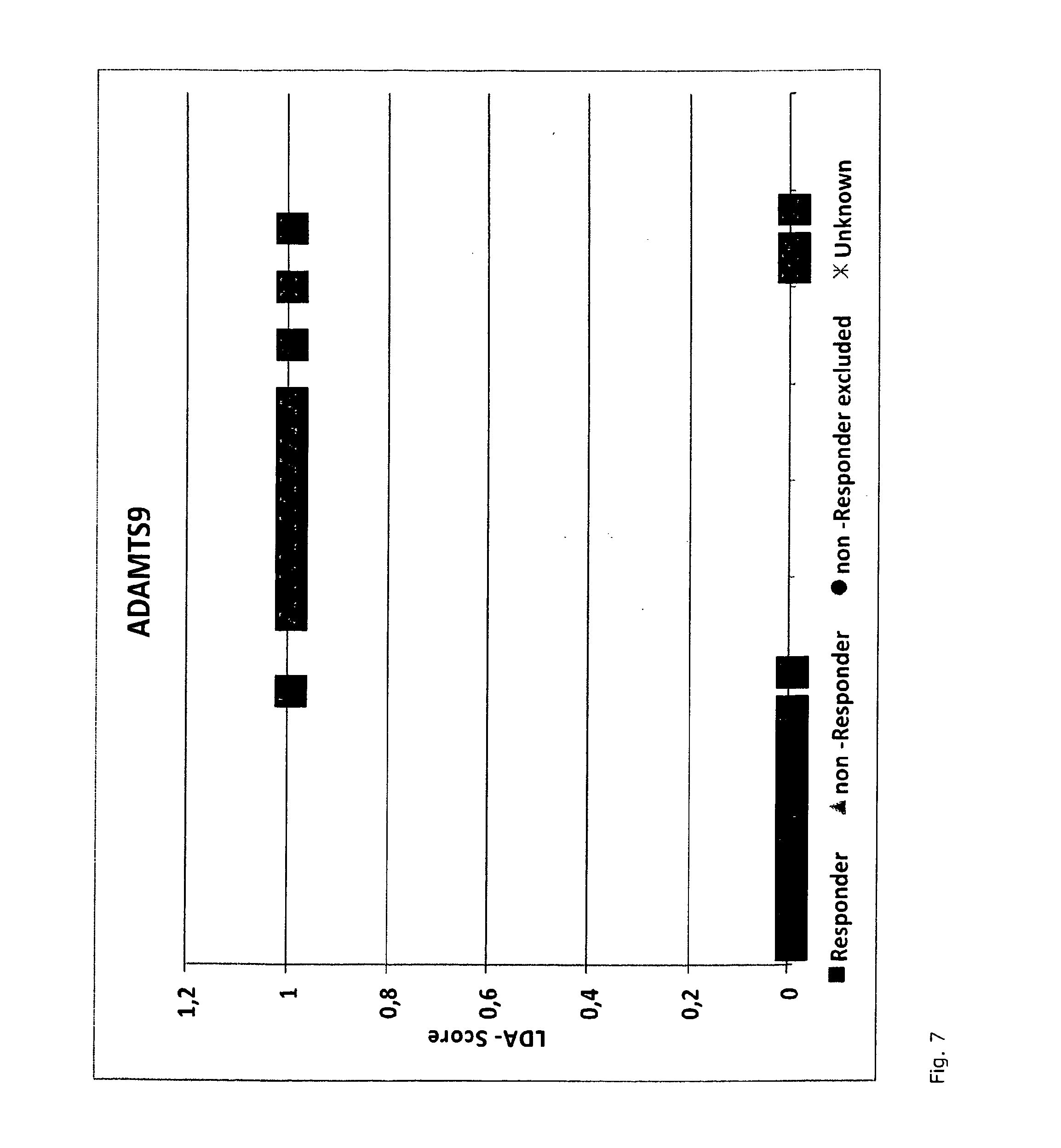Assay and method for predicting therapeutic efficacy of immunoglobulin therapy in individual patients with relapsing remitting multiple sclerosis (rr-ms)
a technology of immunoglobulin and immunoglobulin therapy, which is applied in the field of immunoglobulin therapy assay and method, can solve the problems of significant pathophysiological consequences, extreme pathology, and inability to predict the therapeutic efficacy of immunoglobulin therapy, and achieve the effect of predicting individual responsiveness
- Summary
- Abstract
- Description
- Claims
- Application Information
AI Technical Summary
Benefits of technology
Problems solved by technology
Method used
Image
Examples
example 1
Calculation Involving 9 Individual LDA-Scores
[0164]Determination of SNP results[0165]The homozygous SNP combination of interest related to the KLHDC8A gene is represented by dbSNP RS ID's rs7549293-rs10751436-rs913723-rs913722 with the SNP combination CC-TT-AA-TT (in the same order as given dbSNP RS ID's) indicating a non-responder and contributing “1” for individual LDA-score calculation);[0166]The homozygous SNP combination of interest related to the PRDM9 and OR9Q1 genes is represented by dbSNP RS ID's rs13182871-rs7701403-rs12576939-rs1376486 with the SNP combination GG-AA-TT-GG (in the same order as given dbSNP RS ID's) indicating a non-responder and contributing “1” for individual LDA-score calculation);[0167]The homozygous SNP combination of interest related to the ADAMTS9 gene is represented by dbSNP RS ID's rs9820942-rs6780659-rs6445415-rs11721258-rs11707584-rs7652817-rs13079218-rs9819183 with the SNP combination GG-CC-AA-TT-AA-GG-TT-AA (in the same order as given dbSNP RS ...
example 2
[0183]Calculations involving 2-8 LDA-scores are performed likewise to example 1.
[0184]This method allows the identification of persons responding / non-responding to any immunoglobulin product suitable for in vivo use such as those applied intravenously, subcutaneously, intramuscularly, ocularly, intrathecially, orally, topically or inhalably for diseases which are in principle accessible to immunoglobulin treatment, such as immune mediated inflammatory diseases, autoimmune diseases, allergies, graft-versus-host reactions and prevention of transplant rejection; any kind of multiple sclerosis or any other demyelinating neurological disease; or relapsing-remitting multiple sclerosis.
[0185]The method also permits to predict the probability of a relapse of a MS patient and / or the rate of progression of the disease in terms of disability and or functioning of the patient as measured by clinical scales such as, but not limited to, the expanded disability status scale (EDSS), in particular l...
PUM
| Property | Measurement | Unit |
|---|---|---|
| Density | aaaaa | aaaaa |
| Density | aaaaa | aaaaa |
| Therapeutic | aaaaa | aaaaa |
Abstract
Description
Claims
Application Information
 Login to View More
Login to View More - R&D
- Intellectual Property
- Life Sciences
- Materials
- Tech Scout
- Unparalleled Data Quality
- Higher Quality Content
- 60% Fewer Hallucinations
Browse by: Latest US Patents, China's latest patents, Technical Efficacy Thesaurus, Application Domain, Technology Topic, Popular Technical Reports.
© 2025 PatSnap. All rights reserved.Legal|Privacy policy|Modern Slavery Act Transparency Statement|Sitemap|About US| Contact US: help@patsnap.com



